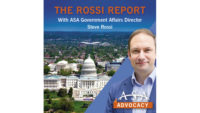A pandemic, a Supreme Court appointment, mail-in ballots, economic uncertainty and a lost laptop have turned the national conversation on its head — and continues create fluidity in a number of races across the country.
National election
As the presidential race stands now, former Vice President Joe Biden continues to lead President Donald Trump by 7.4% nationally (RCP Average). If you look at polls that have been released within the last 24-48 hours, there has been some tightening, depending on the pollster. For example, IBD/TIPP shows Biden +4, while Rasmussen shows Biden +2. While races tend to get closer as we approach Election Day, some of the polling has shown some similarities (and some differences) with 2016.
The polling industry clearly took a hit after the 2016 presidential election, when virtually all polling firms declared an easy victory for former Secretary of State and U.S. Senator Hillary Rodham Clinton. She was consistently shown leading Donald Trump by a substantial margin, however, there were some things that went wrong. While Clinton had a comfortable lead (according to polls), many ignored the fact that the margin was narrowing rapidly as Election Day approached.
In 2016, Clinton was only +2.2% a week out from Election Day (vs. Joe Biden’s +7.4% now). This was critical when it came to the popular vote and how it would affect the Electoral College. Clinton ended up winning by 2.1%, but losing the Electoral College 304-227 (270 votes are needed to win). While many political analysts believe Donald Trump only needs to be within 3-5% of the popular vote to still win, the current numbers make this election very interesting, and is causing pundits to look at the battleground states.
Since the last election, the polling industry has been turned on its head. One school of thought holds that we emulate a characteristic with our British friends across the pond. In the UK, the phenomenon of the “Shy Tory” voter skewed field surveys towards the Labor Party, because some conservative voters were reluctant to give an honest answer to pollsters. In the U.S., there is a similar occurrence with “Shy Trump” voters, where Trump supporters will not give an honest answer to live callers because they either do not trust them or they think it is socially unacceptable to admit they are supporting Donald Trump.
Some studies claim that this can represent 3-5% of those surveyed. To account for this, some polling firms employ “multi-mode” polling. This approach employs a mixture of live calls, email and MMS. Studies have found that many will give a more honest answer and higher take rate on an online poll or text response — as long as they do not have to talk to a live person (there’s also a theory of “Secret Biden” voters, lifelong Republican voters that won’t admit their switch). Will this work? We likely will not know until after the election.
Battleground states
Donald Trump’s 2016 victory was epic for a number of reasons. Not only did he win key battleground states such as Florida, North Carolina, Pennsylvania and Ohio, but he broke through the Democratic Party’s “Blue Wall,” winning traditionally blue states such as Michigan and Wisconsin. The main contribution to those victories was a considerable number of 2012 Obama voters voted for Trump. Whether Donald Trump can retain these voters in 2020 remains to be seen.
Keep in mind that national polls do not always reflect the reality. Consistent with how the Founding Fathers designed it, the presidential election is fought state by state. At the time of this writing, Donald Trump is leading slightly in Ohio (+0.6%), Georgia (+0.4) and Florida (+0.4). All great for Donald Trump, but most political operatives would want to see better numbers for an incumbent. Joe Biden continues to lead in Pennsylvania (+3.8%), Arizona (+2.2%), Iowa (+0.8) and North Carolina (+1.2%), but these leads are also within the margin of error.
GOTV (Get the Vote Out) will be crucial to each campaign, especially with razor-thin margins in polling. Throw in fluid rules on mail-in ballots, early voting and uncertainty about whether polls will be operating on Election Day, campaigns getting their supporters to the polls may be more important than ever before. While Republicans generally like to vote on Election Day and Democrats have embraced early voting since it has been introduced, the pandemic has shifted these patterns. In 2020, requests for mail-in ballots compared to 2016 are up 224%. Ballots returned, compared to 2016, are up 133%. This represents a historic change in how Americans vote.
Taking a look at Florida, where former New York Mayor Michael Bloomberg spent $100 million on behalf of Joe Biden, and Trump-aligned Super PACs have approached that amount, the latest Survey Monkey/Axios poll shows President Trump leading Vice President Biden 49-48%.
Mail-in ballot requests in Florida are up 77% over 2016 with Democrats leading Republican requests 45-31%. Looking at ballots that were returned, the gap closes, with Democrats leading Republicans 43-36%. In the closing week of the campaign, Trump has shifted his remaining resources out of Florida, believing that the GOP ground game there will pull him through. Those funds have been shifted to Midwestern states in order to make a final push.
Election night
This will be an election night like no other, since up to 30% of the vote may still be out in some states. Those votes will have to be counted, especially if the deadline to submit ballots is after the election (some states allow mail-in ballots to be counted up to two weeks after the election, as long as they are postmarked by Election Day).
That being said, the states to watch will be those with polls closing first on the East Coast. If President Trump wins in Florida, Georgia, North Carolina, Pennsylvania and Ohio, he will be off to a solid start. This is his most likely path to victory. In 2016, when he won those states, along with Michigan, Wisconsin and Iowa, the race was over. Should Vice President Biden win Florida, Pennsylvania and/or Ohio, this would signify a tough path ahead for Trump.
In the Senate, there are several incumbent Republicans engaged in the races of their political lives: Sen. Cory Gardner (CO), Sen. Martha McSally (AZ), Sen. Joni Ernst (IA), Sen. Thom Tillis (NC) and Sen. Susan Collins (ME). Currently, the Senate is comprised of 53 Republicans, 45 Democrats and 2 independents (who caucus with the Democrats). While the Republicans have 23 seats to defend this cycle and the Democrats only 12, there are a couple of opportunities for Republicans to flip seats. The first, is Sen. Doug Jones in Alabama. Jones is widely seen as the most vulnerable senator in 2020, being a Democrat in a deep red state. Sen. Jones won his seat in 2018, defeating former Alabama Supreme Court Justice Roy Moore, after allegations of child sexual abuse against Moore were made public. In 2020, Sen. Jones is being challenged by former Auburn University football coach Tommy Tuberville. Tuberville has consistently led by double digits in all polls. The second opportunity to flip a seat is in Michigan. Sen. Gary Peters is being challenged by logistics executive John James. James had such a strong showing against Sen. Debbie Stabenow (D-MI) in 2018, he was recruited to run again in 2020. If elected, he would be the second African-American Republican in the Senate, along with Sen. Tim Scott (R-SC).
As the House is expected to stay in Democratic hands, with the distinct possibility Democrats may increase their majority, Speaker Nancy Pelosi (D-CA) is likely to remain in charge. Some races to watch include Rep. Mike Garcia (CA-25), Rep. Chip Roy (TX-21), Troy Nehls (TX-22), Rep. Collin Peterson (MN-07), Rep. Conor Lamb (PA-17), Rep. Peter DeFazio (OR-04) and Rep. Max Rose (NY-11). These races may indicate which way the political winds are blowing on election night.
In the future, the 2020 election cycle will be studied by political science students in the years ahead. However, with all that has happened over the last seven months, the race for president will likely come down to two questions: 1) Which candidate is best equipped to protect the country from further COVID-19 outbreaks? and 2) Which candidate is the best to help foster a rapid economic recovery?
Please remember to vote and enjoy watching the returns on election night. You will not want to miss what should be a very interesting evening.



